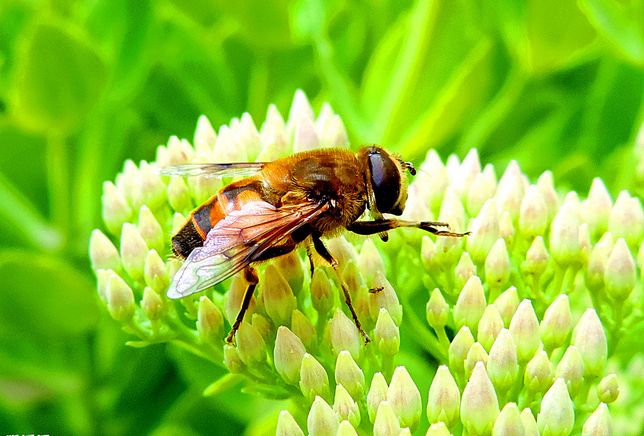(单词翻译:单击)
中英文本
Science and technology: Evolution: Bee kind to viruses
科学技术:进化:蜜蜂爱病毒
A strange tale of collaboration between plants, pathogens and insects.
植物、病毒和昆虫的奇特合作。
Cucumber mosaic virus is not restricted to its eponymous host.
黄瓜花叶病毒能感染不是只有黄瓜。
They could also ravage tomatoes—stunting them and causing them to produce contorted tendril-like leaves.
这种病毒也荼毒番茄——病株会长出卷曲的病叶。

Given this devastation, it is surprising susceptible plants continue to exist; natural selection should have produced resistance years ago.
考虑到病毒的危害,至今还存在易感染植物着实让人惊奇——自然选择应该早就帮助它们形成了病毒抵抗力。
A paper in this week’s PLoS Pathogens, however, explains the apparent contradiction.
本周,PLoS Pathogens发表的一篇论文解释了这一明显矛盾。
The team that wrote it, led by John Carr of Cambridge University, found that the virus actually helps its host to reproduce.
发表这篇文章的团队由剑桥大学的约翰·卡尔带领,他们发现病毒实际上在帮助宿主繁衍。
It does so using an unsuspecting accomplice: the bumble-bee.
而达成这种目标借助的不是别的,正是大黄蜂。
Like many discoveries, this one was accidental.
像很多发现一样,这个发现也纯属偶然。
Dr Carr had ordered some equipment to analyse the volatile chemicals emitted by infected tomato plants.
卡尔博士订购了一些设备用来分析番茄病株释放的易挥发化学物质。
While he was waiting for it to arrive, a colleague offered to lend him some bees, as these pollinators are known for their sense of smell.
在等候交货的这段时间,一位同事提出借给他一些蜜蜂,因为这些传粉使者具有灵敏的嗅觉。
His team placed both healthy and infected plants in a greenhouse, covered them so that the bees could smell but not see them, and released the insects.
于是团队人员把正常植株和感染植株一同放到温室,遮盖它们确保蜜蜂只能嗅到而不能看到它们,然后释放蜜蜂。
The bees could indeed tell the difference—but to Dr Carr’s surprise they did not favour the healthy plants.
蜜蜂确实可以嗅出植株的不同,但令卡尔博士感到惊讶的是,它们并不喜欢健康植株。
Rather, they strongly preferred the infected ones.
相反,它们对感染植株青睐有加。
For some viral strains, they were four times more likely to visit an infected plant than a healthy one.
有一些受感染的病株甚至能吸引比健康植株多三倍的蜜蜂。
Subsequent experiments, carried out after the analytical apparatus had arrived, showed that this difference in behaviour was, indeed, a response to differences in the chemicals that infected and uninfected plants give off.
在分析设备到货以后进行的后续实验揭示了蜜蜂区别对待植株的原因——感染植株和健康植株释放的化学物质不同。
The question was how the bees’ preference played into the plants’ evolution.
那么蜜蜂的偏爱在植物进化中起到了什么作用呢?
Tomatoes are able to fertilise themselves, without need of a pollinator, yet even this self-pollination can be assisted by a bee visiting a flower.
番茄可以自我繁衍,不需要传粉者,但是如果有蜜蜂来传播花粉,这种自花授粉的植物也会得到帮助。
Vibrations caused by the insect’s buzzing help release pollen from the flower’s anthers so that it can fall onto the stigma.
昆虫翅膀的震动帮助播撒取自花药的花粉,并落到柱头上。
Could this process, Dr Carr wondered, make up for the evolutionary disadvantage the virus otherwise inflicts?
卡尔博士疑惑这个过程能否弥补病毒在其他方面带来的进化劣势。
To investigate, he and his colleagues grew both healthy and infected tomatoes in a greenhouse with no bees, and a similar mixture in a greenhouse into which bees were released one at a time, and their movements tracked.
为了进一步调查,卡尔博士和同事在一个温室里种植了健康番茄和感染番茄,但是没有蜜蜂,又在另一个温室里进行同样的种植,但是向这个温室每次释放一只蜜蜂,并追踪它的轨迹。
They then analysed the seeds of the fruits of each plant as a proxy for evolutionary fitness.
之后他们选取每株番茄的种子作为进化适应性的代表进行分析。
All of the seeds they looked at seemed viable.
他们观察的种子似乎都有望存活。
What differed was the number of seeds in each fruit.
不同点在于每个番茄果实内所含的种子数量。
In the bee-free greenhouse, infected plants had only about 50 seeds per fruit, whereas healthy ones averaged 70.
在没有蜜蜂的温室里,感染番茄平均每个果实仅含50枚种子,健康番茄70枚。
When bees were present, though, something strange happened.
在蜜蜂活动的温室里,神奇的事情上演了。
The seed count of fruits from healthy flowers visited by bees increased to 85—but that of the flowers of infected plants jumped much higher, to 115.
蜜蜂拜访过的健康番茄果实内的种子增长至85枚,而感染番茄跃升至115枚。
Further investigation showed a possible reason.
更深入的调查提供了可能的解释。
Not only did bees visit the infected plants more, but they also spent longer buzzing around infected flowers.
感染番茄不仅能吸引更多蜜蜂,还能让它们环绕感染植物飞舞更久。
The extra pollen thus displaced probably explains how the sickly plants outproduced their healthy confreres.
充裕的花粉很可能是这些生病植株比它们健康的同伴更高产的原因。
Using these experimental data, the researchers modelled how the system might have evolved.
研究人员运用实验数据模拟了这一系统可能的发展过程。
They found that the pollinator’s preference for the smell of infected plants was big enough to stop the emergence of viral-resistance in tomatoes.
他们发现,传粉者对感染植株味道的青睐足以阻止番茄形成病毒抵抗力。
That explains what is in it for the tomatoes and also for the virus.
这同样解释了番茄和病毒的利害关系。
What the bees get out of it, though, remains mysterious.
但是蜜蜂能从中分一杯什么羹,还是个谜。
翻译:Angela
重点讲解
1.natural selection 物竞天择;自然淘汰
例句:Darwin thinks that natural selection is the chief factor in the development of species.
达尔文认为自然淘汰是物种发展中的主要因素。
2.get out of 逃避;避免
例句:It's amazing what people will do to get out of paying taxes.
人们为逃税而做出的种种事情令人吃惊。
3.at a time 一次;每次
例句:Can I borrow two books at a time?
我可以一次借两本书吗?
4.make up for 弥补
例句:Her beauty can't make up for her stupidity.
她的美丽不能弥补她的愚蠢。


